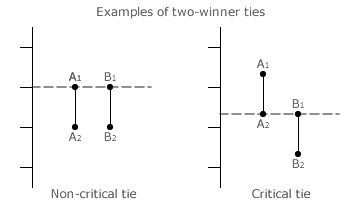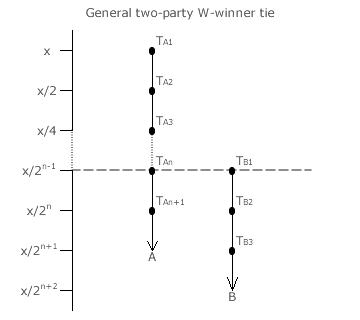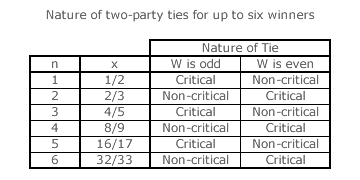Map Construction: Two-Party CHPV Maps
Two-party (S = 2) two-winner (W = 2) scenario: Two parties A and B field two candidates each in a party-list CHPV election to fill two vacant seats. Let the proportion of voters V preferring A to B be x and those preferring B to A be y; so x + y = 1. For each party, its candidates are ranked from 1 to W on its closed list; where here W = 2. Candidates are identified below by their party and rank position. The standard CHPV weightings with a = 1 and the standard election profile notation and formats are used below to determine the tally (T) for each party and candidate.

- TA = xV(1 + 1/2) for the election profile x: A1,A2.
- TB = yV(1 + 1/2) for the election profile y: B1,B2.
The tally share for party A (tA) and for party B (tB) is hence x and y respectively. Party stick diagrams can now be drawn for particular values of x and y that specify critical or non-critical ties. On each party stick, consecutively ranked candidates have consecutively halved tallies. Notice that it is only the relative proportions (x and y) of the tallies that is important; not their absolute values.
Two examples are shown opposite. The non-critical tie results when the two parties A and B have an equal vote share (x = y = 1/2). The two seats are awarded to the prime candidate in each party. However, a critical tie between the two parties occurs when the support for party A is double that for party B; where x = 2y (so x = 2/3 and y = 1/3).

Here, A1 is awarded the first vacant seat and the second one goes to either A2 or B1 selected at random. If support for party A was to increase (x > 2/3) then both A candidates would be elected. Similarly, if support for party B exceeded twice that for party A, then both B candidates would win. Otherwise, when each party receives between one third and two thirds of the vote each, then each party wins one seat. These three different seat share domains are shown on the CHPV two-party two-winner map opposite.
Two-party (S = 2) multiple-winner (W = W) scenario: Two parties A and B field W candidates each in a party-list CHPV election to fill W vacant seats. Let the proportion of voters V preferring A to B be x and those preferring B to A be y; whereby x + y = 1. For each party, its candidates are ranked from 1 to W on its closed list. Candidates are identified below by their party and rank position. The standard CHPV weightings with a = 1 and the standard election profile notation and formats are used below to determine the tally (T) for each party and candidate.
- TA = xV[1 + 1/2 + ...... + 1/2W-1] for the election profile x: A1,A2,~~~~,AW.
- TB = yV[1 + 1/2 + ...... + 1/2W-1] for the election profile y: B1,B2,~~~~,BW.


The tally share for party A (tA) and for party B (tB) is again x and y respectively. The party stick diagram for this general case of a tie between a candidate of one party ranked nth on its list being level with the prime candidate of the other one is shown opposite; so y = x/2n-1.
For a three-winner election (W = 3), there is a critical tie when A3 is level with B1 or B3 is level with A1. A random tie break is needed here to select the actual winner of the last of the three vacant seats. This critical tie occurs when one party has four times the support of the other; namely when x = 4y or y = 4x. Hence, one party has four fifths of the vote and the other has one fifth.
For a five-winner election (W = 5), there is again a critical tie when the tally ratio between the two parties is 4:1. However, it is now either A4 or B2 (or B4 or A2) that wins the random tie break for the fifth and final seat. There is another critical tie when the tally ratio is 16:1. With this level of support, either A5 ties with B1 or B5 ties with A1.
For a four-winner election (W = 4), there is a critical tie when the tally ratio is 2:1 just as there is for a two-winner election (W = 2). However, it is the next candidate down on each list that is now hoping to win by random selection. The additional critical tie here is when the tally ratio is 8:1 as the last seat is taken either by A4 or B1 or by B4 or A1. For a six-winner election (W = 6), there is another pair of critical ties when the tally ratio is 32:1 as well as for 8:1 and 2:1.
For every extra seat in an election, one extra pair of critical ties is added to its two-party map. For up to six winners, the table opposite lists the critical ties that occur in two-party contests. For an even number of seats, there are W/2 pairs of critical ties between parties A and B. For an odd number, there are (W+1)/2 such pairs.
Fully completed two-party maps for up to six winners are presented in the Evaluations: CHPV Maps section.
Return to main text > Evaluations: Diagrams & Maps 5
Refer to > Map Construction: Table of Contents
